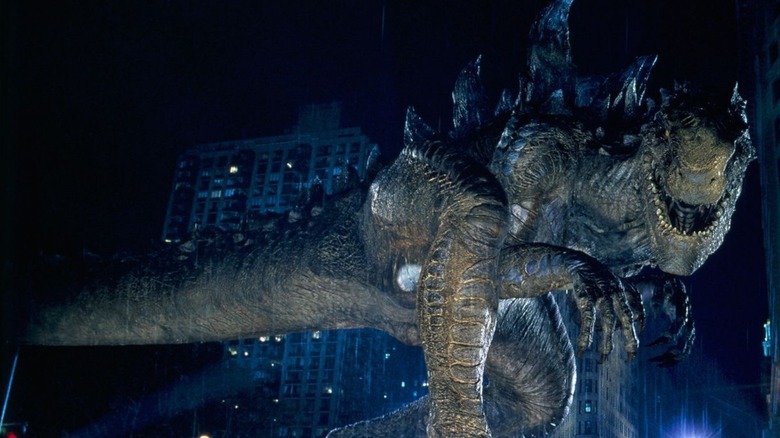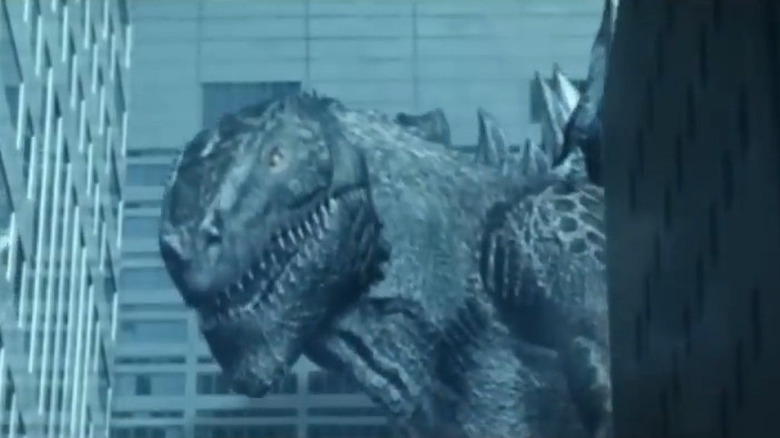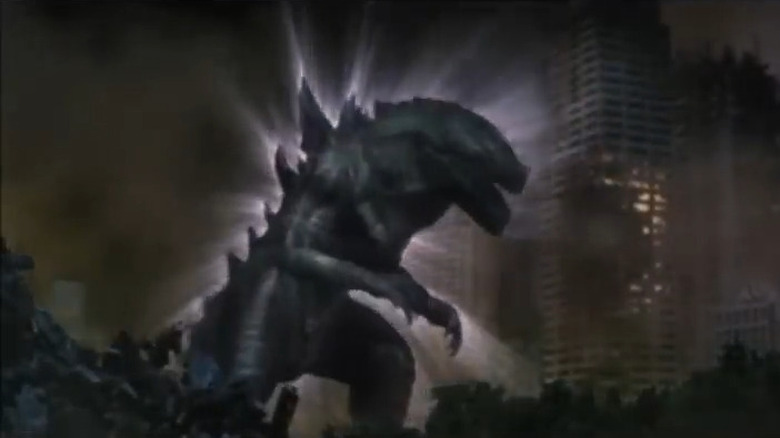The Godzilla Fans Hated The Most Was Given A Humiliating Second Death
Roland Emmerich's 1998 film "Godzilla" remains of the most widely seen in the Godzilla film series, and also remains one of the most broadly reviled. "Godzilla" is an unapologetically stupid film that has more in common with chintzy Irwin Allen disaster movies from the 1970s than it does with anything Godzilla-related. The film's ubiquitous ad campaign famously touted that "SIZE DOES MATTER," a churlish claim, given that the monster in the movie was smaller than any of the Godzillas seen to date. Indeed, the giant iguana-resembling reptile was small enough that it could slip into the subways of New York City and remain hidden for an entire day.
Emmerich's "Godzilla" was initially planned as the first of three Godzilla movies to be made by TriStar pictures, and the studio was willing to spend a lot to make the first entry in their borrowed franchise (borrowed from Toho). The budget on "Godzilla" ran anywhere from $130 million to $150 million, which was a massive fortune in 1998.
Emmerich's film made $379 million worldwide, but that wasn't enough for the studio. It didn't help that "Godzilla" was greeted with ridicule from audiences and sneers from critics; it currently holds a mere 20% approval rating on Rotten Tomatoes. Seemingly wanting to school any American studio that foolishly believed they could make a Godzilla film correctly, Toho took Godzilla back and, in 1999, released "Godzilla 2000," the first film in a new rebooted timeline called the Millennium Era.
The sixth film in the Millennium Era was Ryuhei Kitamura's "Godzilla: Final Wars," meant to be the last word on Godzilla. In that film, characters noted that the Emmerich Godzilla was indeed part of the Godzilla canon, but that it was a small, weak creature that Americans only mistook for the real Godzilla.
That's not Godzilla, that's just Zilla
One has to admire Toho for their pride and temerity. They farmed the Godzilla name out to an American studio, the American studio fouled it up, and Toho took the name back, saying that the monster in the American film wasn't actually Godzilla. Instead, the monster was re-named Zilla, and would go on to fight the real Godzilla in "Godzilla: Final Wars." Rather notoriously, the fight between Zilla and Godzilla would be the shortest in Godzilla history.
The plot of "Final Wars" follows a conspiracy enacted by a species called Xilians who take control of Earth's monsters and use them to destroy property. The film features almost every monster to have appeared in a Godzilla movie. Zilla is manifested in Sydney, Australia. When Godzilla appears, Zilla charges and leaps at him. Godzilla bats Zilla aside, knocking it into the Sydney Opera House. The Opera House explodes. Godzilla unleashes his nuclear breath, and Zilla is destroyed. The whole scene lasts maybe 45 seconds.
The inclusion of the American Zilla in "Godzilla: Final Wars" was evidently Ryuhei Kitamura's idea. "Final Wars" producer Shogo Tomiyama explained Kitamura's thinking in author Keith Aiken's extended oral history of Emmerich's film called "Godzilla Unmade," and he said:
"Kitamura asked me if it was possible for us to use the American Godzilla in 'Final Wars,' so I checked our contract with Sony Pictures and found out we could use it. Since this was the 50th anniversary film, I thought 'Why not include the American Godzilla?' [...] There is some special meaning to having him in this film — but mostly, we just wanted to show which Godzilla is stronger."
An easy answer.
Toho taxonomy
Toho famously provided a booklet to the initial "Final Wars" audiences offering them a handy list of the many monsters that were to appear in the film. Some casual observers, for instance, may not recognize Kumonga. In was in this booklet that Zilla was named for the first time, described as:
"A monster, similar in appearance to an iguana, that attacks Sydney. Its true identity is unknown, but according to one theory, it may be the same monster that struck New York in 1997. There are many common features such as its fast movement and consumption of tuna, but its authenticity remains a mystery."
That's very diplomatic, and in keeping with Toho's tendency to resurrect a monster with a new "official" name. The Mecha-King Ghidorah seen in "Godzilla vs. King Ghidorah," for instance, is technically a different monster from the King Ghidorah seen earlier in the film. As such, Zilla could be ... could be ... a different monster from the one seen in Emmerich's film.
But I think we all know the truth. "Final Wars" sought to show Godzilla asserting his dominance over the American monster the same way the Japanese franchise was asserting its dominance over the proposed American series. One might have noticed similar timing when Gareth Edwards' American "Godzilla" was released in 2014. It only took Toho until 2016 to reboot Godzilla back at home and release the excellent "Shin Godzilla," a vastly superior film.
It wouldn't be until 2023 that an American Godzilla ("Monarch: Legacy of Monsters") and a Japanese Godzilla ("Godzilla Minus One") would simultaneously co-exist in the pop landscape.


